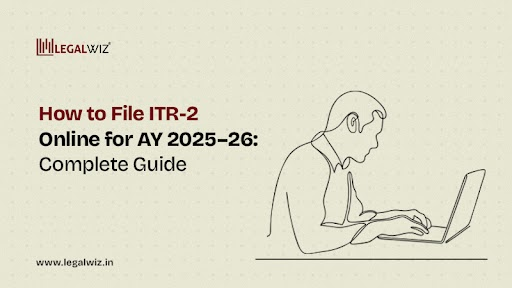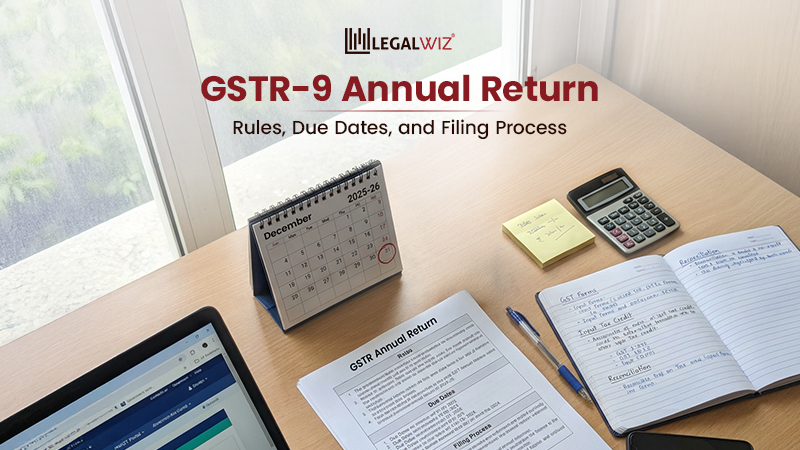How to File ITR-2 Online for AY 2025–26: Complete Guide
If filing ITR 2 feels like trying to untangle your earphones from 2010, messy, frustrating, and making you question your life choices, you’re not alone. Many taxpayers open the e-filing portal only to feel like they’ve walked straight into a tax jungle with no map.
But here’s the good news: this guide is your shortcut through the chaos of Income Tax Return Filing. We’re turning ITR-2 filing online into easy, bite-sized steps—no confusing tax talk, no panic, and zero caffeine emergencies. By the end, you’ll know exactly where to click, what to fill, and how to smash that glorious ‘Submit’ button like a pro!
(Spoiler alert: You might even find yourself thinking, “Hey, that wasn’t so bad!”)
What is ITR 2?
Not all taxpayers are created equal, and neither are their tax return forms. ITR 2 is the go-to form for individuals and Hindu Undivided Families (HUFs) whose incomes are a bit more “complex” than a plain salary cheque and one cozy house property.
Here’s what makes ITR 2 your match:
- You’ve sold shares, mutual funds, or property and made capital gains.
- You own more than one house property (even if one is vacant or rented).
- You’ve got foreign income or assets abroad (yes, even that foreign bank account you forgot about counts).
- You receive dividends or other sources of income besides salary.
But let’s be clear:
- If you earn from a business or profession, ITR-1 and ITR-2 aren’t enough; you need ITR-3. We’ve put together a handy guide on ITR filing for business owners to make it super easy.
Why this matters: Picking the wrong ITR form isn’t just a minor typo; it can make your return invalid, leading to notices, penalties, or worse, a delayed refund. So getting this right saves you a world of post-filing headaches.
If ITR 1 is like instant noodles, done in 2 minutes and no fuss, ITR 2 is a home-cooked thali. More ingredients, more prep, but the end result feels a whole lot more satisfying (and legit).
Here’s a breakdown of ITR 1 and ITR 2 for a better understanding:
| Feature | ITR 1 (Sahaj) | ITR 2 |
| Who Can File | Individuals with income from salary, 1 house property, and other sources (like bank interest) | Individuals & HUFs with capital gains, multiple house properties, or foreign income/assets |
| Who Can’t File | If you have capital gains, more than 1 house property, foreign income/assets, or income > ₹50 lakh | If you earn from a business/profession (you’ll need ITR 3) |
| Complexity Level | Beginner-friendly—done in minutes | Intermediate—needs more info & documents |
| Capital Gains | Not allowed | Required if applicable |
| Foreign Income/Assets | Nope | Yes |
| Best For | Salary earners with a simple income structure | Taxpayers with investments, property sales, or global earnings |
| Filing Time | Quick coffee break | One coffee + snacks + patience |
| Risk of Choosing Wrong | Return invalid + possible penalties | Same story—choose wisely! |
| Portal Mood | Oh, this is easy! | Okay, let’s focus! |
If ITR-1 is your ideal form and ITR-2 isn’t your thing, we’ve got a simple step-by-step guide on how to file ITR-1 without any hassle. Just make sure you check which form fits you; choosing the wrong one can cost you!
Pre-Filing Prep – Your Tax Filing Survival Kit
Before you even think about hitting that “File Now” button, do yourself a favor: get your tax backpack ready. Filing ITR 2 without the right documents is like showing up for a road trip without fuel or snacks… you’re going nowhere fast, and the frustration will hit hard.
And if you want to dive deeper into who should file, when to use it, and why it matters, check out our guide: Who Should File ITR-2? and file your ITR the right way!
Here’s your must-pack list for a smooth ride:
- PAN & Aadhaar: Your tax ID essentials—you literally can’t start without these.
- Bank account details: To receive your refund (because you don’t want the taxman holding on to your money forever).
- Form 16: If you’re salaried, this is your income statement from your employer.
- AIS (Annual Information Statement) & TIS (Taxpayer Information Summary): These two are like your “tax mirror”; they show what the Income Tax Department already knows about your income.
- Capital gains statements: If you sold property, stocks, or mutual funds, these records keep your tax math on point.
- Proof of deductions: From 80C investments to 80D medical insurance, gather every document that earns you a tax break.
Why this matters: Missing even one of these can mean wrong calculations, errors in filing, or worse, a notice from the tax department asking you to explain yourself. And trust us, those letters are about as fun as a root canal.
Think of this as packing for a trip. Forget your charger, and you’re doomed. Forget your Form 16, and you’re staring at an incomplete return, wondering where it all went wrong.
Step-by-Step Process to File ITR 2 Online – Your Tax GPS for FY 2025–26
Filing ITR 2 isn’t rocket science… but without a roadmap, it can feel like you’re wandering in a tax maze. Here’s your turn-by-turn guide to make it from “login” to “filed and verified” without detours or headaches.
Step 1: Log in to the Income Tax e-Filing Portal
- Head over to incometax.gov.in
- Sign in using your PAN or Aadhaar, password, and captcha.
Tip: Make sure your contact details (email, mobile) are updated; this is where the department sends OTPs and important alerts.
Step 2: Start a New Return → Select AY 2025–26 & ITR 2
- Choose the option to File Income Tax Return.
- Select:
- Assessment Year: 2025–26 (for income earned in FY 2024–25)
- ITR Form: ITR 2
Why this matters: Selecting the wrong form is like trying to fit into someone else’s shoes; it won’t end well and may invalidate your return. And to make sure you don’t choose the wrong form, learn about forms from ITR 1 to ITR 7.
Step 3: Enter Income Details
On the following page, you’ll see 5 schedule categories. Start by clicking ‘General’, then select ‘Income Schedule’.
- Fill out all relevant sections for:
- Salary/Pension (cross-check with Form 16)
- House Property (even if vacant or rented out)
- Capital Gains (shares, mutual funds, property sales)
- Foreign Assets or Income (don’t skip this, non-disclosure is a big red flag)
Pro tip: If you’ve sold stocks or property, keep your broker statements and purchase details handy for accurate capital gains reporting.
Step 4: Claim Your Deductions
- Use the right sections for 80C, 80D, 80G, and others you’re eligible for.
Why this matters: Missing deductions = paying more tax than you should. No one likes gifting extra money to the taxman.
Step 5: Add Bank Details for Refund Credit
- Enter your active bank account number and IFSC.
- Ensure it’s pre-validated on the portal to avoid refund delays.
Step 6: Validate Entries to Avoid Red Flags
- Use the ‘Validate’ button after filling in each schedule.
- This ensures you haven’t left out any mandatory fields or made silly errors.
Step 7: Preview Your Tax Calculation
- The system computes your tax liability or refund automatically.
- Tip: Cross-check this with your own calculation (or a CA) to ensure the numbers make sense.
Step 8: Pay Extra Tax, If Due
- If you owe additional tax, you’ll be redirected to make an online payment via Net Banking, UPI, or Debit Card.
- Skipping this step = return treated as “defective.”
Step 9: Submit & E-Verify (Within 30 Days)
Filing your ITR is just the first step—once it’s submitted, you need to verify it. There are several ways to do this, but our guide on how to e-Verify ITR online in minutes makes it super simple. Before diving in, take a quick glance at what’s ahead.
- Hit ‘Submit’, then choose your verification mode:
- Aadhaar OTP
- Net Banking
- Electronic Verification Code (EVC)
You can also send a signed ITR-V to CPC Bangalore, but online verification is faster.
Hit ‘Save Draft’ every few minutes, because nothing hurts more than losing unsaved tax data. It’s like getting Wi-Fi cut off during the climax of your favorite series.
What Happens After Filing ITR 2? (A Peek Behind the Tax Curtain)
You’ve finally hit ‘Submit’, done a mini victory dance, and sworn never to procrastinate on taxes again (until next year). But what happens on the other side of the screen after you file? Here’s the post-filing journey, minus the mystery:
Instant Acknowledgment (Proof You Did It)
- As soon as you file and e-verify, you get an acknowledgment number, your digital receipt from the Income Tax Department.
- This number is your “tax ticket”, confirming your return has been successfully submitted. Keep it safe, you might need it later.
CPC Processing – The Tax Department’s Quality Check
- Your return goes to the Centralized Processing Centre (CPC), where it’s checked against:
- TDS details from Form 26AS and AIS
- Any tax already paid or pending
- Income details you declared vs. what they know about you
- If there are mismatches or missing info, expect a notification asking for clarification.
Refund Arrives (If the Taxman Owes You)
- If you’ve paid more tax than necessary, your refund gets processed and credited directly to your linked bank account.
- Timeline: Usually within 2–6 weeks, but can take longer if there are discrepancies.
- Tip: Make sure your bank account is pre-validated on the portal, no one wants a refund stuck in limbo.
Intimation Under Section 143(1)
- After processing, you receive a formal intimation email. This document states:
- Your return is accepted as filed
- Or, discrepancies were found (extra tax payable or refund adjustments)
- This is basically the final seal of approval from the IT department for that year’s filing.
Think of this like online shopping: you place the order (file), get a tracking ID (acknowledgment), your package is checked at the warehouse (CPC), and then either you get the delivery (refund) or a message saying, ‘We need to talk about your order.’
ITR-2 Filing Mistakes to Avoid (Bonus: Save Yourself the Future Headache)
Filing ITR 2 is like assembling IKEA furniture; follow the instructions, and you’ll be fine. Skip a step or grab the wrong part, and you’ll be sitting on a wobbly chair, wondering what went wrong. Here are the classic blunders taxpayers make and how to steer clear of them:
Choosing the Wrong ITR Form
- The mistake: Filing ITR 1 when you actually have capital gains or foreign assets.
- Why it’s bad: Your return gets treated as invalid, meaning you’ll have to re-file and risk late penalties.
- How to avoid it: Always double-check eligibility before you start—think of it as wearing the right shoes before a marathon.
Missing Capital Gains or Foreign Income Details
- The goof-up: Forgetting to report stock market trades, property sales, or that small foreign bank account you once opened.
- Why it’s bad: The tax department already has most of this info through AIS. Skipping it = notice in your inbox and potential fines.
- How to avoid it: Keep broker statements and foreign income documents handy. Enter every rupee earned—no matter how small.
Forgetting Bank Details or E-Verification
- The goof-up: Filing the return but leaving out bank details or forgetting to verify it within 30 days.
- Why it’s bad: Refunds get stuck, and your return may be treated as not filed at all.
- How to avoid it: Always add a pre-validated bank account and e-verify instantly (Aadhaar OTP takes less than a minute).
An unverified return is like baking a cake and forgetting the frosting—technically done, but not really complete. And let’s be real, who eats cake without frosting?
Skip the Drama, File with LegalWiz
We know, all of these can be a DIY adventure… but let’s be honest, not everyone enjoys playing tax detective at midnight. If you’d rather swap confusion for clarity, LegalWiz.in’s tax experts have your back.
Here’s what you get when you let us take the wheel:
- Expert-backed filing: Every number double-checked, every form error-proofed.
- Faster refunds: Because who doesn’t love money landing in their account sooner?
- Zero guesswork: No more googling “Why is my ITR rejected?” at 2 AM.
- Compliance without chaos: We handle the rules, you handle… well, anything else you’d rather be doing.
Think of it as ordering pizza instead of cooking dinner after a long day. Why stress when you can sit back and let the pros do it right?
Book a free consultation
Wrapping It Up: ITR 2 Doesn’t Have to Be a Horror Story
Filing ITR 2 may look like a maze of forms, figures, and endless tabs on the e-filing portal—but with the right prep, a clear step-by-step plan, and a little patience, it’s absolutely doable.
From gathering your documents to hitting that final ‘e-Verify’ button, each step is just about being organized, accurate, and a bit cautious. And remember, the tax department isn’t out to get you; they just want the right info, on time, without surprises.
So, whether you’re going full DIY mode or letting experts (like LegalWiz) handle the heavy lifting, know this: filing ITR 2 on time saves you from penalties, late-night tax stress, and refund delays.
Taxes are unavoidable, but the headache doesn’t have to be. File smart, file early, and keep your next caffeine fix for a coffee date, not a 2 AM tax panic session.
Frequently Asked Questions
Is ITR 2 the right form for me?
Think of ITR forms like Netflix profiles, pick the one that matches your “genre” of income. If you’ve got capital gains, multiple house properties, foreign income, or dividend income, ITR 2 is your match. But if you’re running a business or profession, swipe left, it’s ITR 3 for you.
What documents do I need before filing ITR 2?
You wouldn’t pack for a vacation without your passport, right? Same here. Keep your PAN, Aadhaar, bank details, Form 16, AIS/TIS, capital gains statements, and deduction proofs ready. Forgetting one is like forgetting your charger; you’ll regret it fast.
What happens if I pick the wrong ITR form?
It’s like showing up to a wedding in a swimsuit, completely wrong for the occasion. Your return may be treated as invalid; you’ll have to refile, and you might even face penalties. Always check the form rules before you start.
How soon will I get my refund after filing ITR 2?
If everything’s correct, you could see it in 2–6 weeks. But if there’s a mismatch, it might take longer, like waiting for that “out for delivery” package that never arrives. Pro tip: Make sure your bank account is pre-validated to avoid refund limbo.
Can LegalWiz file my ITR 2 for me?
Absolutely! We’re like your tax GPS, no wrong turns, no dead ends. From error-proof filing to faster refunds, we handle the tax jungle so you can handle literally anything else.

Sapna Mane
Sapna Mane is a skilled content writer at LegalWiz.in with years of cross-industry experience and a flair for turning legal, tax, and compliance chaos into clear, scroll-stopping content. She makes sense of India’s ever-changing rules—so you don’t have to Google everything twice.







